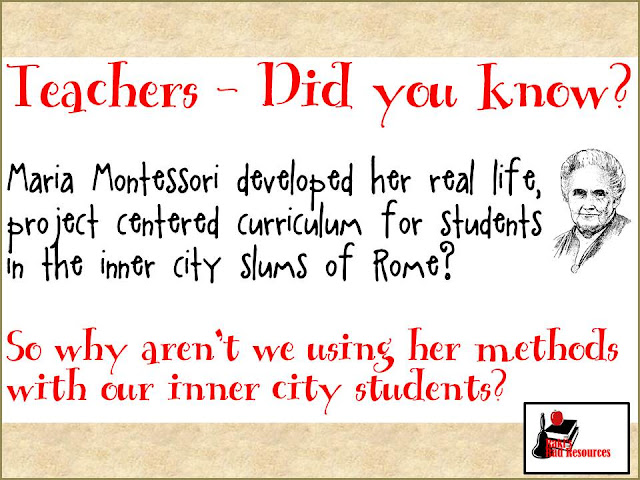In my experience, I have found that low level / low income students often don't get access to the same projects and higher level thinking activities that their higher level / higher income peers do. Mainly this is because teachers feel like there isn't time for those things when students are behind in basic skills. So instead, we spend a lot of time drilling and skilling low level students in hopes that they will remember those basic facts because of the repetition.
Now I'm a big fan of repetition. I use it in certain ways in my classroom. It's great for building math fact fluency or memorizing site words. It can also be helpful for building classroom routines. But, it's not the end all and be all of education. In fact, it often leads us to the quote "Doing the same thing over and over again, but expecting different results is the definition of insanity." Understanding content and using critical thinking skills to solve a problem do not come from drill and skill repetition. Those types of understanding come from making connections between what we already know and what we are learning.
Brain based learning research shows us that students need to be able to connect what they are learning with background knowledge in order to understand and remember what they are reading. One thing that many of our low level students are lacking is background knowledge. So realistically the best thing we can do to help our low level students is to build their background knowledge. Student will more background knowledge learn faster. As teachers we know this to be true because we see it in our classroom all the time. I can personally think of multiple students in my classroom right now who do better not because they have better processing skills but because they have more background knowledge to connect to.
Projects are a wonderful way for students to build their background knowledge. They are also a wonderful way for students to make connections between different background knowledge that they already have because projects ask them do work with multiple different skills and concepts simultaneously.
Another thing that brain based learning research shows us is that students (and people in general) remember things better if they are invested in them. The choices that projects allow students make it more likely that they will be invested in these learning experiences. For example, my students who are working on country study projects have chosen their countries for their own personal reason. This gives them buy in and personal investment in their learning, ownership if you will. How many students take ownership for drill and skill worksheet learning?
Maria Montessori is famous for developing a hands-on curriculum that gets students engaged in learning through real life projects like cooking meals. Few people remember that her first famous schools was in a poor, inner city area of Rome. She saw unprecented growth in students of low income, low background knowledge and low academic levels. Why then are our American Montessori schools private and geared towards middle to high income students? Why are we not using the Montessori methods, or at least project based learning, in our low income/ low level schools with the kids who need these methods most?
I teach in a school like this and I try to incorporate as many projects as I can. Here are a few of the projects I have used this year with my 3rd graders:

What projects are you going to do with your low level/ low income students?








No comments:
Post a Comment